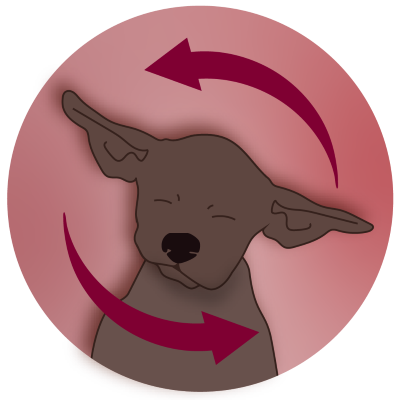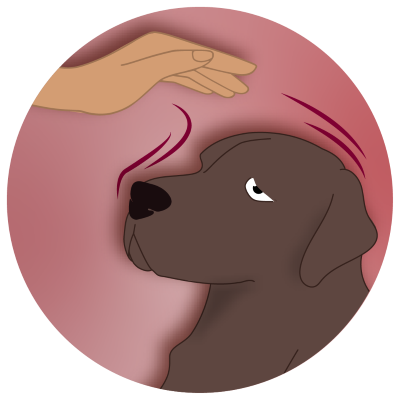Four reasons dogs keep shaking their heads
Head shaking is normal dog behaviour. Without fingers and thumbs, dogs instinctively shake their heads to relieve discomfort, itchiness or irritation; it’s an effective way to clear the ear canal of water, dirt, or insects. But while the occasional head shake isn’t cause for concern, regular and persistent head shaking is abnormal and could signal a potentially serious health issue.
It’s important to understand why dogs shake their heads and to look for the signs that indicate a medical problem. Learn about four common medical reasons your dog might be shaking their head frequently:
1. Otitis externa
Otitis externa (OE) is the medical term for inflammation of the skin in the outer ear canal, often caused by an ear infection. It’s a leading cause of vet visits for dogs, and in most cases requires medical treatment and won’t go away on its own.
Symptoms of otitis externa:
OE comes with a range of symptoms:
 Itching & scratching ear
Itching & scratching ear Shaking head
Shaking head Ear smelling bad
Ear smelling bad
 Reddened, sore ear
Reddened, sore ear Reluctance to have ears touched
Reluctance to have ears touched Discharge from ear
Discharge from ear
Causes of otitis externa and ear infections in dogs:
Causes of otitis externa and ear infections can vary but include:
- bacterial or yeast overgrowth
- parasites such as ear mites
- an allergic problem
- other factors such as plant materials like grass awns which can become trapped in the ear canal
- trapped water in the ear
Some dogs are more likely to develop ear infections due to having a certain ear structure, such as a small or narrow ear canal or floppy ears. These dogs are particularly at risk of recurrent ear infections, as are dogs that are more susceptible than others to environmental factors and allergens that may cause ear swelling, soreness and infection.
Treating otitis externa:
Canine otitis externa can be very painful for your dog and if left untreated, ear inflammation can worsen and lead to permanent changes to the structures of the ear, possibly affecting hearing as well. If you suspect your dog is suffering from an ear infection or inflammation, contact your vet immediately.
After an examination, your vet may recommend a topical treatment containing antibacterial, antifungal and anti-inflammatory agents, which your vet can apply directly into your dog’s ear. Other treatment options require daily at-home applications over the course of one or two weeks; fully completing treatment is crucial.
2. Ear damage or trauma
While dogs are usually sturdy animals, they can sometimes injure themselves — while going for a run, playing at the dog park or adventuring along a wooded trail. If you notice a change in your dog’s behaviour (suddenly lethargic, subdued or showing signs of ear pain and sensitivity), it's important to consult your vet right away.
3. Ear haematomas
An ear haematoma is a painful, blood-filled swelling that forms when a blood vessel within the ear flap (called the pinna) ruptures, causing blood and fluid to collect in a pool between the skin and the cartilage. It results in a droopy and swollen ear flap, the skin may be inflamed (red) and painful to touch.
Haematomas are typically caused by some kind of self-trauma, such as overly aggressive scratching or head shaking resulting from an underlying medical condition, such as an ear infection, ear mites or allergies.
Left untreated, the blood will clot and eventually scar but may cause a permanent deformity to the ear flap. To prevent this from happening, it’s important to take your dog to the vet for treatment, especially as they can be really uncomfortable for your dog. In some cases the haematoma can be drained with a needle and syringe, however the swelling may come back afterwards. If this happens, surgery might be needed. The vet will also determine what underlying condition caused the scratching and head shaking in the first place and address this appropriately. In many cases, a bacterial infection or itchy skin condition may be present.
3. Ear vasculitis
Ear vasculitis, or inflammation of the walls of the blood vessels in the ear flaps, results in a possibly severe skin condition on the flap of your dog’s ears. Common symptoms of ear vasculitis include:
- Red or purple spots on the ears
- Crusting of the skin
- Fluid-filled cysts
- Hair loss
- Itchiness and pain at the affected site
The cause of ear vasculitis is unknown in many cases. Possible causes can include an abnormal immune response, infections, adverse reactions to drugs and cancer. If you notice the signs of ear vasculitis in your dog, consult your vet right away for diagnosis and treatment.
What to do if your dog keeps shaking its head
Chronic head shaking is just one indicator of a potentially serious health issue - so if your dog's head shaking is frequent and lasts for more than a day, or if your dog has red, swollen and smelly ears, consult your vet right away.
Want to know more?

What do ear infections in dogs look like?
What you need to know about ear infections in dogs and treatment options.

Pet insurance: your essential guide
Everything you need to know about insurance for your pet.

Activate 10% off* Petplan
Receive a 10% off introductory offer when you insure your pet online with our partner Petplan today.
